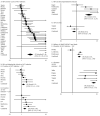Impact of human immunodeficiency virus infection on the course of hepatitis C virus infection: a meta-analysis
- PMID: 19248201
- PMCID: PMC2653408
- DOI: 10.3748/wjg.15.996
Impact of human immunodeficiency virus infection on the course of hepatitis C virus infection: a meta-analysis
Abstract
Aim: To analyze the influence of human immunodeficiency virus (HIV) infection on the course of hepatitis C virus (HCV) infection.
Methods: We performed a meta-analysis to quantify the effect of HIV co-infection on progressive liver disease in patients with HCV infection. Published studies in the English or Chinese-language medical literature involving cohorts of HIV-negative and -positive patients coinfected with HCV were obtained by searching the PUBMED, EMBASE and CBM. Data were extracted independently from relevant studies by 2 investigators and used in a fixed-effect meta analysis to determine the difference in the course of HCV infection in the 2 groups.
Results: Twenty-nine trails involving 16750 patients were identified including the outcome of histological fibrosis or cirrhosis or de-compensated liver disease or hepatocellular carcinoma or death. These studies yielded a combined adjusted odds ratio (OR) of 3.40 [95% confidence interval (CI) = 2.45 and 4.73]. Of note, studies that examined histological fibrosis/cirrhosis, decompensated liver disease, hepatocellular carcinoma or death had a pooled OR of 1.47 (95% CI = 1.27 and 1.70), 5.45 (95% CI = 2.54 and 11.71), 0.76 (95% CI = 0.50 and 1.14), and 3.60 (95% CI = 3.12 and 4.15), respectively.
Conclusion: Without highly active antiretroviral therapies (HAART), HIV accelerates HCV disease progression, including death, histological fibrosis/cirrhosis and decompensated liver disease. However, the rate of hepatocellular carcinoma is similar in persons who had HCV infection and were positive for HIV or negative for HIV.
Figures
References
-
- Sherman KE, Rouster SD, Chung RT, Rajicic N. Hepatitis C Virus prevalence among patients infected with Human Immunodeficiency Virus: a cross-sectional analysis of the US adult AIDS Clinical Trials Group. Clin Infect Dis. 2002;34:831–837. - PubMed
-
- Sulkowski MS, Thomas DL. Hepatitis C in the HIV-Infected Person. Ann Intern Med. 2003;138:197–207. - PubMed
-
- Thomas DL. Hepatitis C and human immunodeficiency virus infection. Hepatology. 2002;36:S201–S209. - PubMed
-
- Tossing G. Management of chronic hepatitis C in HIV-co-infected patients--results from the First International Workshop on HIV and Hepatitis Co-infection, 2nd-4th December 2004, Amsterdam, Netherlands. Eur J Med Res. 2005;10:43–45. - PubMed
Publication types
MeSH terms
LinkOut - more resources
Full Text Sources
Medical


